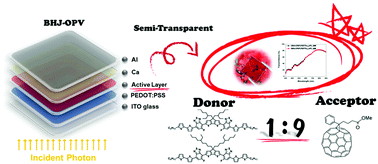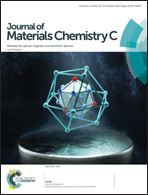Semi-transparent low-donor content organic solar cells employing cyclopentadithiophene-based conjugated molecules†
Abstract
Considering the facile synthesis of the cyclopentadithiophene (CPDT) building block, this study aims to synthesize and characterize two donor–acceptor type conjugated molecules, 2EH-CPDT(FBTTh2)2 and 5EN-CPDT(FBTTh2)2, with different branching points from the backbone. It was found that the branching point variation strategy slightly tunes the optical and electrochemical properties of the resulting conjugated molecule films owing to the difference between their intermolecular packing. When used as a donor material in PC71BM-based organic solar cells (OSCs), the power conversion efficiency of 2EH-CPDT(FBTTh2)2 is twice that of the ones processed using 5EN-CPDT(FBTTh2)2. Interestingly, with no post treatments, OSCs were optimized with especially low-donor content within the active layer (donor : acceptor weight ratio = 1 : 9), which allows construction of a highly transparent film with a visible transmittance over 50%, showing potential for application in integrated photovoltaics.



 Please wait while we load your content...
Please wait while we load your content...
